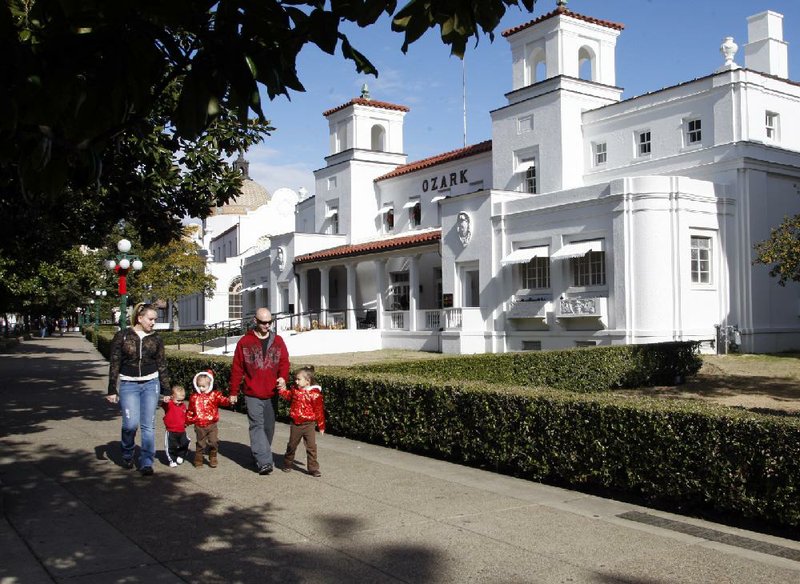Since 2002, Libby Smith and her husband have run Bear Creek Log Cabins in St. Joe near the Buffalo National River. Designated as the United States' first national river in 1972, the Buffalo is one of Arkansas' most popular National Park Service sites.
Smith says being located near a national park keeps business booming -- nearly every day during the summer, Bear Creek's five cabins are full of tourists.
"We get 'em from everywhere, even from other countries," she said.
Last year, the National Park Service tallied more than 1.1 million visitors at the Buffalo River. Those tourists spent about $46 million with local hotels, campgrounds, restaurants, gas stations and souvenir shops, supporting an estimated 637 Arkansas jobs, according to a National Park Service report released this month.
The report, produced annually by the park service, tracks the economic effects of visitor spending in communities near its parks and landmarks.
In Arkansas, the study's authors found that nearly 2.8 million visitors to national parks spent $144.3 million last year -- money that helped support about 2,070 jobs statewide. The state has seven National Park Service sites: Arkansas Post National Memorial in Gillett, Buffalo National River in north Arkansas, Fort Smith National Historic Site, Hot Springs National Park, Central High School National Historic Site in Little Rock, the President William Jefferson Clinton Birthplace Home National Historic Site in Hope and Pea Ridge National Military Park in Garfield.
The Trail of Tears National Historic Trail also goes through Arkansas, but was not included in the report.
Nationwide, the report found that 2013 park visitors spent an estimated $14.6 billion in nearby communities -- close to 2012's $14.7 billion despite October's government shutdown and ongoing park clean-up from 2012's Hurricane Sandy.
During the 16-day shutdown, the Park Service worked with state governments in Arizona, Colorado, New York, South Dakota, Tennessee and Utah to keep some parks open, but sites in Arkansas and elsewhere were shuttered.
Even with the brief closure, Hot Springs National Park drew more than 1,325,000 tourists -- making it the most-visited Arkansas park in 2013. Those visitors spent $80 million and supported an estimated 1,140 area jobs, the study found.
Steve Arrison, CEO of Visit Hot Springs, said the national park designation is a driver of the local economy.
"Hot Springs National Park is definitely one of the key attractions for tourists that come to Hot Springs," he said. "[Without it], I would think we'd still have the natural beauty, we'd still have the five lakes and the horse racing. But you know, there's just something special about a national park."
To calculate a park's economic effect, the National Park Service looked at tourist spending within a 60-mile radius of a park site -- an area known as the park's gateway community. Study authors then multiplied that spending by regional economic multipliers, which are values for each area determined using data from the Bureau of Economic Analysis, the Bureau of Labor Statistics and the U.S. Census Bureau.
The largest share of visitor spending -- 30.3 percent -- went to lodging. Another 20.1 percent went to restaurants and bars while 12.1 percent of tourist travel costs went to gas. About 10 percent went to actual admission fees and the remainder was split between groceries, camping, local transportation, souvenirs and other costs.
Jeff Olson, a National Park Service spokesman, said determining a park's economic effect is more complicated than just figuring out the total amount spent by visitors.
"Let's say you're at a cafe in a gateway community, you're buying lunch," he said. "[Study authors] aren't just looking at the job of the waitress or waiter and the cook; they're figuring in the job that creates your hamburger bun and the hamburger patty."
The Central High National Historic Site drew 114,000 people to Little Rock last year, whose $6.3 million in local spending helped support 94 jobs, the study found. Site Superintendent Robin White said she sees visitors, who mainly stay in downtown hotels, coming to the site via taxis and tour buses.
White said she would love to see even more businesses tapping into tourism by locating near the site and developing relationships with the Park Service.
"Our goal is to become an economic engine in the community," she said, "and the way to do that is to invest in the community -- it's the only way to do that."
Metro on 07/26/2014
